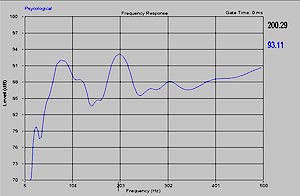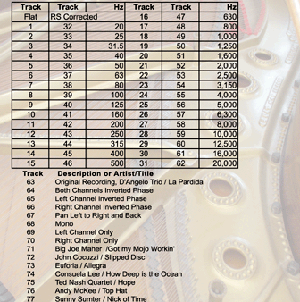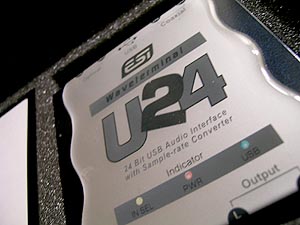|
 |
|
|
 |
|
|
|
Richard, how does your Level-2 service expand on what Level-1 provides?
|
|
 |
|
|
|
In Level-2, we -- or our dealer/representative in that specific market -- take an actual acoustical measurement in the room we're working on. All our dealers have our professional test kit to perform precise, on-site acoustical mapping.
|
|
|
Let's say we deal with a pre-existing space. Outside of our absorptive/diffusive and mechanical notch filter treatments, it won't change dimensions. We now take in-room measurements at the outset of the job. This actual -- rather than theoretical as with Level-1 -- data increases our accuracy when we run our prognostic software calculations. While real-world listening/living rooms aren't true reverberant fields like theaters, our RT-60 based measurement protocol provides extraordinarily high resolution.
This nets extremely high significance and precision, of spectral energy time-curve/waterfall plots and frequency response. Combined, these measurements generate a three-dimensional acoustical map of the room. Because of the additional data's heightened accuracy, our engineering time involvement increases exponentially over Level-1.
The second unique feature of Level-2 over Level-1 is a second set of measurements. That's performed when the majority of the installation is complete. Certain devices we prescribe are actually tunable. Additionally, we don't mount all the predicted absorptive/diffusive elements until this second set of measurements. This enables us to precisely tune the remainder of the treatment and the adjustable devices to create a highly accurate inverse response curve against the room's original, to cancel out aberrations and, as we did with Jacob's room, create specific aural impressions that suggest a far larger space than we're actually in.
Put differently, the second set of measurements becomes the real-world correlation against the predictive software simulation and allows us to account for the minor offsets between theory and practice. We simply adjust certain parameters of our tunable elements and correct for a room mode with the precise amount of attenuation, at the precise frequency.
|
|
|
 |
|
 |
|
 |
|
|
 |
|
 |
|
|
real measurement of uncorrected room showing critical areas of necessary address
|
|
 |
|
|
Can you give us an example of these tunable devices?
One of them happens to be these corner traps we're using here in Jacob's room. They sport wooden backplates we can exchange to reduce absorptive efficiency. If, for example, too much bass were absorbed, we could selectively 'board off' sections to tune the absorptive coefficient to the desired tonal balance.
Let's talk about the dead/live-end principle and how it relates to consumer rather than professional spaces.
Contrary to certain audiophile notions, the live/dead-end recipe originated with the professional recording industry. Say you're in a concert hall, with live performers producing music on a stage which is usually highly reflective and sometimes perhaps moderately diffusive. The audience meanwhile is in a highly diffusive, absorptive soundfield, the latter quality a natural function of multitudes of bodies congregating.
Now see those microphones, suspended in the middle of the air where no listener could possibly ever sit? They capture the musical information from a very different acoustic perspective than the audience: With very short reverberation times but without the diffuse sound field of the hall.
Let's go into the recording studio. The recording engineer is sitting behind his mixing console faced by his studio monitors. His speakers become stand-ins for orchestral soundstage (albeit studio or theater) for him to, as accurately as possible, recreate the musical performance that his microphones have captured. To simulate the acoustics of the orchestral stage for this engineer as the microphones did, he must do it with short reverberations times. This mandates a well-damped, absorptive environment aka the dead end. So while he wants a more reflective/diffuse area behind him, the recording engineer's speakers are in a dead-end space. Hence in a studio, the live/dead-end recipe places the live end behind the listener, the dead end in front of him.
The audiophile music lover meanwhile wants to be back in the concert hall, to hear the music as though sitting in the diffuse field of the original audience. Thus in the home listening space, the live/dead-end scheme of the recording studio must be reversed. The speakers now become the musicians on a reflective, moderately diffuse stage [live end] while the listening chair duplicates the audience seat in an absorptive/diffuse dead-end space. So at home, the live-end is in front of the listener, the dead-end behind him - exactly opposite from the setup needed in the recording studio or mastering facility. |
|
|
 |
|
 |
|
 |
|
 |
|
 |
|
|
 |
|
 |
|
|
And that's, naturally, how we at Rives Audio design our listening rooms - with a strongly reflective environment upfront that preserves the kinetic energy, and an absorptive/diffuse field surrounding the listener so he hears the music as though sitting in the diffusive field of the audience, but with the short reverberant times of the original sound stage and venue intact.
Let's talk about the Helmholtz resonators here in Jacob's space.
We actually specified quite a lot in this room because, relative to the speakers being used, it was on the small side [approximately 13' x 19' x 8'], with the staircase transformed into a highly absorptive area which you'll have noted walking up and down while observing the sound of your own voice or foot steps. The Helmholtz resonators in this room are used to broaden the soundstage. They absorb energy and then release it at an attenuated level to create a sense of ambience that fools the ear/brain mechanism into hearing this space as being much broader and wider than it is. In most rooms, we would not have this many resonators. But we usually do need some as they also assist in smoothing out the frequency response, providing both diffusion and absorption.
Can you explain exactly how they work?
These here are fashioned from hardwood slats with a 1/4 inch gap. The width and depth of the gap relative to the depth of the device determines the frequency it resonates at. Because these are convex -- and most of the ones we use are rounded -- the depth of the gaps isn't constant but varying to become effective over a broader frequency band. Most people think of Helmholtz resonators as high-Q devices - and you can design them accordingly to attenuate specific bass modes. But these are not that. These are broad-band devices designed to improve the ambiance of the room.
How would a high-Q variant differ in construction?
We're designing a room right now that suffers a 6dB peak where ceiling height and room width were pretermined and unalterable. I knew that those two dimensions were going to interact. Our software predicted 4-5dB @ 77Hz. I didn't design the Helmholtz resonator right away, only the space wherein to house it. I wanted to take the actual measurements of the room upon completion, not rely on the potential minor difference between predictive theory and on-site hard reality - which turned out to be 6-7dB @ 80Hz, a small but significant offset if accuracy is your goal. I had to broaden the area of the resonator since that determines the rate of attenuation. This resonator isn't a slotted but perf board design where the hole size, spacing and depth of the cavity determines the operative frequency and the Q is fixed by how rigid the cavity is and how much stuffing it contains.
This particular device will be extraordinarily high-Q, lined with felt, built from layers of 3/4" plywood lapped with screw and glue construction and cloth cover - rigid without pouring concrete. [Laughs.] It looks just like any of the absorption panels this client will have in other parts of the room, to achieve a congruent aesthetic appearance. However, the acoustical function of this particular section will be very different from the others. The actual siting of the device within the room depends on frequency, listening position and which modes are the culprits that create the problem in the first place. In this case, the critical area is parallel to the listening position and over to one side. The resonator covers almost the entire wall floor-to-ceiling, with about 3.5 feet width. It takes a large surface area to attenuate this type of severe problem.
With Level-2, the pricing for new construction vs retrofit is identical as the time we save on the first measurement -- with new construction, there isn't a first measurement -- gets rolled into the extra design time necessary to specify a from-the-ground-up room.
|
|
 |
|
 |
|
 |
|
 |
|
 |
|
 |
|
|
|
|
 |
 |
|
|
 |
|
|
|
|
|
|
|
|
|
|
|
|
|
|
|
|